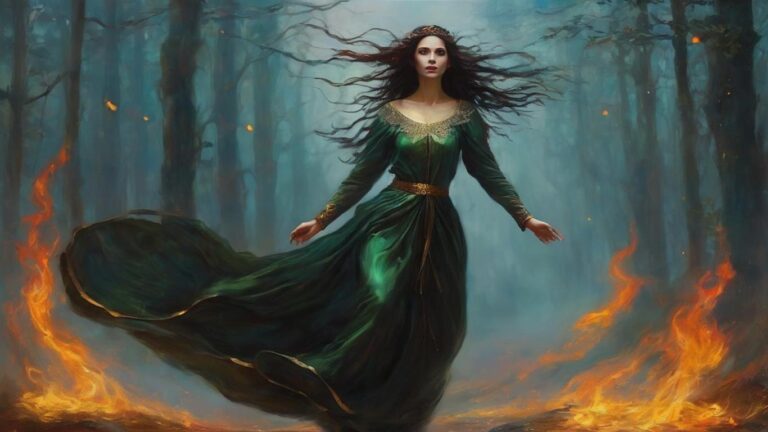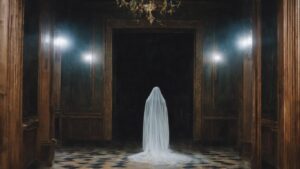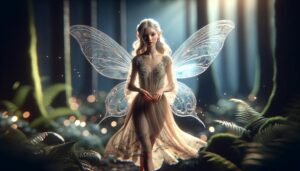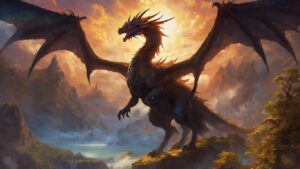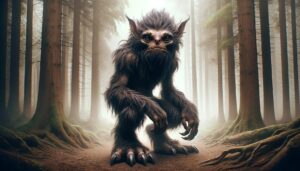Table of Contents
What is a Banshee?
Traditionally, a banshee is said to wail or keen, producing a mournful and eerie sound, especially at night. The keening is believed to forewarn of an impending death in the family that the banshee is linked to. The banshee’s appearance may vary, but she is often described as a woman with long hair, dressed in white or gray robes, and sometimes with red or green eyes.
In Irish folklore, the banshee is considered a supernatural messenger, and her keening is both a lament for the deceased and a warning to the living. While the concept of the banshee is rooted in Irish mythology, similar supernatural beings with death-related roles exist in various cultures around the world.
Physical Description
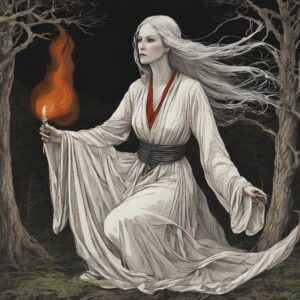
The physical description of a banshee can vary in different accounts and folklore traditions. However, there are some common characteristics often associated with banshees in Irish mythology:
Female Form: Banshees are typically depicted as female entities. The name “banshee” itself is derived from the Irish words “bean sí,” which means “woman of the fairy.”
Long Hair: Banshees are often described as having long, flowing hair. This hair is sometimes depicted as wild and unruly.
White or Gray Robes: In many accounts, banshees are said to wear white or gray robes. These robes are often described as flowing or ethereal.
Keening or Wailing: One of the most distinctive features of a banshee is her keening or wailing. This mournful and eerie sound is believed to be a forewarning of an impending death.
Red or Green Eyes: Some stories attribute banshees with having red or green eyes, adding to their supernatural and otherworldly appearance.
Glowing Appearance: In certain accounts, banshees are said to have a supernatural glow or aura surrounding them.
Personality
In Irish folklore, banshees are not typically described as having distinct personalities in the way that humans do. Instead, they are often portrayed as supernatural beings with a specific role: that of a harbinger of death. The banshee’s primary function is to forewarn certain families of an impending death, usually by wailing or keening.
The emotional aspect associated with banshees is often linked to mourning and sorrow. Their keening is a mournful and eerie sound that is both a lament for the deceased and a warning to the living. This gives them a somewhat melancholic or sorrowful quality, as they are intimately connected with the process of death and the grief that follows.
While banshees are not typically described as having human-like emotions or motivations, their presence in folklore serves to evoke a sense of the supernatural and the mysterious. They are symbolic figures associated with the transition between life and death, and their appearances are often tied to specific families or lineages.
In popular culture and modern interpretations, banshees may be portrayed with more nuanced personalities, especially in works of fiction such as literature, movies, or television. In these cases, authors and creators might take creative liberties to develop more complex characters with emotions, motivations, and personal histories.
Special Abilities
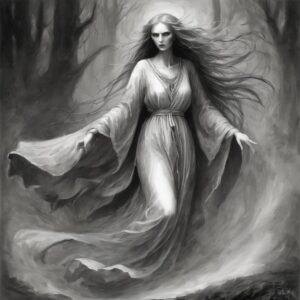
In Irish folklore, banshees are primarily known for their ability to forewarn of death through their distinctive wailing or keening. However, specific abilities attributed to banshees can vary across different traditions and stories. Here are some common special abilities associated with banshees:
Keening or Wailing: The most well-known ability of a banshee is her eerie and mournful wailing. This sound is believed to be heard in proximity to a family that is about to experience a death. The banshee’s keen is both a lament for the deceased and a warning to the living.
Shape-shifting: In some folklore, banshees are said to have the ability to change their appearance. They may appear as an old hag, a beautiful woman, or a spectral figure, depending on the circumstances.
Invisibility: Some stories suggest that banshees can be invisible to humans while they carry out their supernatural activities. They may only reveal themselves audibly through their keening.
Connection to Otherworldly Realms: Banshees are often associated with the fairy or spirit world. Their presence is considered otherworldly, and they may have a connection to the supernatural realms beyond the understanding of humans.
Ability to Pass Through Objects: In certain tales, banshees are described as having the ability to pass through physical barriers or obstacles effortlessly.
Origin of banshee
The origin of the banshee is rooted in Irish folklore and mythology, and the concept has been a part of Irish cultural traditions for centuries. The word “banshee” itself is derived from the Irish term “bean sí,” where “bean” means woman, and “sí” refers to the fairies or spirits. The banshee is often considered a fairy woman or spirit associated with certain families.
The role of the banshee is primarily that of a harbinger of death. She is believed to appear or wail in proximity to the homes of specific families to forewarn them of an impending death. The association of the banshee with particular families suggests a familial or ancestral connection.
The exact origins of the banshee legend are challenging to pinpoint, as folklore tends to evolve over time through oral traditions and cultural influences. The concept of supernatural beings associated with death is not unique to Irish folklore, and similar figures exist in various cultures worldwide.
Modern Appearances
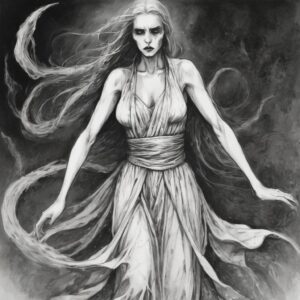
Indeed, the banshee has maintained a presence in modern popular culture, making appearances in various forms of entertainment, including literature, film, television, and even in Halloween-themed contexts. Here are a few examples of how the banshee has been depicted in modern media:
Television Shows:
Scooby-Doo: The animated series “Scooby-Doo, Where Are You!” features an episode titled “A Night of Fright is No Delight,” where a banshee is one of the spooky elements.
Teen Wolf: The TV series “Teen Wolf” includes a storyline involving banshees. In this show, banshees possess supernatural abilities related to death.
Movies:
Darby O’Gill and the Little People (1959): This Disney film features a banshee as a character. The banshee’s appearance is depicted as a harbinger of death.
The Banshee Chapter (2013): A horror film that draws inspiration from H.P. Lovecraft’s works and involves mind-altering substances and mysterious occurrences.
Literature:
Contemporary Fantasy Novels: Banshees often make appearances in modern fantasy literature. Authors may incorporate the traditional Irish folklore elements or create unique interpretations of the banshee myth.
Halloween and Popular Culture:
Halloween Decorations: The banshee, with its eerie and haunting qualities, is sometimes incorporated into Halloween decorations, haunted house themes, and other spooky festivities.
While modern depictions of the banshee may deviate from the traditional Irish folklore, the essence of the wailing harbinger of death often remains a central theme. The banshee’s enduring presence in popular culture showcases its ability to capture the imagination and continue to be a compelling figure in the realm of supernatural and mythical beings.
Symbols
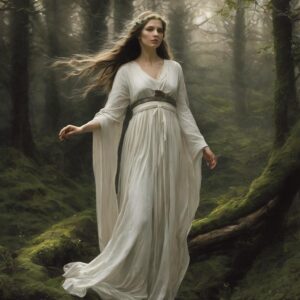
The banshee, deeply rooted in Irish folklore, is associated with several symbols that convey aspects of her supernatural nature and role as a harbinger of death. While banshee symbolism may not be as standardized as some other mythical figures, certain elements are commonly associated with her in various cultural representations. Here are some symbols often linked to the banshee:
Wailing or Keening Sound: The banshee’s distinctive wail is a powerful auditory symbol. It represents her role as a messenger of death and is often depicted as a mournful sound that forewarns of impending tragedy.
White or Gray Robes: The banshee is frequently portrayed wearing white or gray robes, symbolizing her connection to the spirit or fairy realm. These colors may also convey purity or otherworldly qualities.
Long Flowing Hair: The banshee’s long, flowing hair is a visual symbol that adds to her ethereal and supernatural appearance. It may signify a connection to the otherworldly and emphasize her mysterious nature.
Red or Green Eyes: In some depictions, banshees are said to have eyes that glow red or green. This symbolism may emphasize their otherworldly and magical attributes, contributing to a sense of the supernatural.
Familial Connection: The banshee’s association with specific families or lineages symbolizes her role as a guardian or forewarner of death within those bloodlines. Her appearance is often seen as a sign of impending loss within a particular family.
Crying or Mourning Gesture: In visual representations, banshees may be depicted with a mourning or crying gesture, reinforcing their connection to death and grief.
Celtic Symbols: As a figure from Irish folklore, the banshee may be associated with broader Celtic symbols, such as knots, spirals, or other traditional designs, emphasizing her cultural origins.
Veil Between Worlds: The banshee is sometimes seen as a being that can traverse the boundaries between the mortal world and the spirit realm. This concept is symbolized by her ability to appear and deliver her warnings.
What is a banshee?
A banshee is a supernatural being or spirit in Irish folklore and mythology. The name "banshee" is derived from the Irish term "bean sí," meaning "woman of the fairy." Banshees are often associated with specific families and are believed to be harbingers of death.
What does a banshee do?
The primary role of a banshee is to forewarn certain families of an impending death. This is often done through a distinctive wailing or keening sound, serving as both a lament for the deceased and a warning to the living.
Are banshees evil or good?
In traditional Irish folklore, banshees are not inherently classified as evil or good. They are supernatural beings with a specific role, and their actions are more aligned with their function as messengers of death.
What is the real meaning of banshee?
The term "banshee" is derived from Irish and translates to "woman of the fairy." The real meaning lies in its association with a female spirit or supernatural being connected to specific families and foretelling death.
What happens if you see the banshee?
Seeing a banshee is traditionally considered an omen of death within the family she is linked to. It is believed to foretell the imminent passing of a loved one.
Is banshees sad?
Banshees are often associated with sorrow and mourning due to their wailing and keening. Their presence is linked to death, and their actions convey a sense of grief.
Is banshee a myth?
Yes, the banshee is a figure rooted in mythology and folklore, particularly in Irish traditions. While the concept of the banshee is mythological, it has endured and been adapted in various forms of literature and popular culture.
Are Banshees friendly?
Banshees are not typically portrayed as friendly beings. Their role is to announce death, and their appearance is often linked with mourning and sorrow.
Are Banshees only female?
Traditionally, banshees are depicted as female entities. The name "banshee" itself means "woman of the fairy." However, there are rare accounts of male banshees in some folklore.
Why are Banshees scary?
Banshees are considered scary due to their association with death and their eerie wailing. The anticipation of an impending loss and their supernatural qualities contribute to their frightening nature.
How do banshees look like?
Banshees are often described as women with long, flowing hair, dressed in white or gray robes. Their appearance may be otherworldly, and they may sometimes be depicted with red or green eyes.
Is banshee violent?
In traditional folklore, banshees are not described as violent. Their role is more passive, foretelling death through their wailing rather than actively causing harm.
Can a banshee be a witch?
The concepts of banshees and witches are distinct in folklore. While banshees are associated with death and mourning, witches are often portrayed as individuals with magical powers.
Can banshees be evil?
Banshees are not inherently evil in traditional Irish folklore. They are supernatural beings with a specific role tied to death and mourning.
Are Banshees attractive?
Depictions of banshees' attractiveness can vary in modern interpretations. Traditionally, they are more associated with otherworldly beauty than conventional attractiveness.
How powerful is a banshee?
The power of a banshee lies in her ability to forewarn of death through her wailing. She is often depicted as having a connection to the supernatural or fairy realms.
Can a boy be a banshee?
While banshees are traditionally depicted as female, there are rare accounts in folklore of male banshees. However, the female aspect is more commonly emphasized.
Is a banshee immortal?
The immortality of banshees is not clearly defined in folklore. They are often portrayed as long-lived or eternal beings, but the concept of true immortality may vary.
Does the banshee have a name?
Banshees are not typically given personal names in folklore. They are often referred to generically as "the banshee."
What do banshees fear?
Folklore does not provide specific information about what banshees might fear. Their role is more focused on foretelling death rather than personal fears.
What defeats a banshee?
Traditional folklore doesn't necessarily provide ways to defeat a banshee since they are messengers rather than malevolent entities to be confronted.
Why is banshee good?
The concept of a "good" banshee is not common in traditional folklore. Their role is more about fulfilling a specific function in forewarning of death.
What do Banshees scream?
Banshees are often said to emit a wailing or keening sound, which is mournful and eerie. The precise nature of the scream may vary in different cultural interpretations.
How do Banshees fly?
Traditional folklore does not typically attribute flying abilities to banshees. Their supernatural nature is more associated with their foretelling abilities and connection to the spirit realm.
Do Banshees heal?
Healing is not a characteristic traditionally associated with banshees. Their role is more centered around death and mourning.
Are banshees magical?
Banshees are often depicted as having a connection to the supernatural or magical realms, particularly in their ability to forewarn of death through their keening.
How do banshees move?
The traditional folklore does not provide specific details about how banshees move. Their appearances are often sudden and mysterious.
Are banshees vengeful?
Banshees are not typically portrayed as vengeful in traditional folklore. Their role is more about signaling the inevitability of death rather than seeking retribution.
